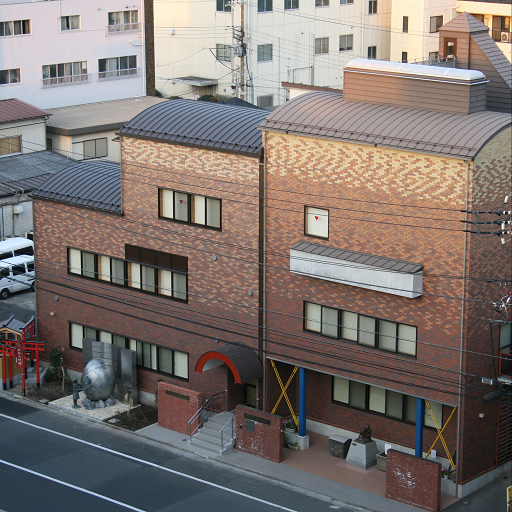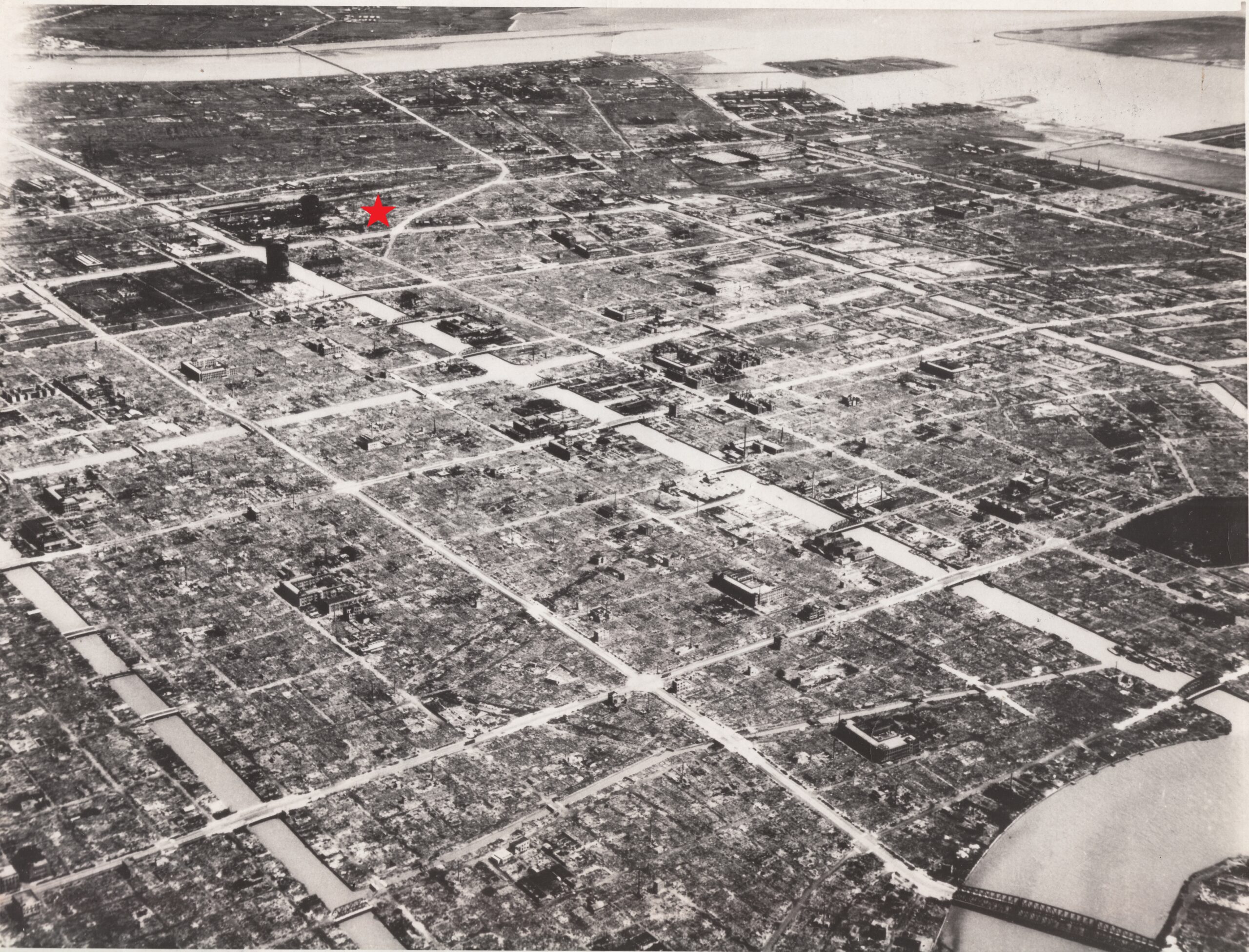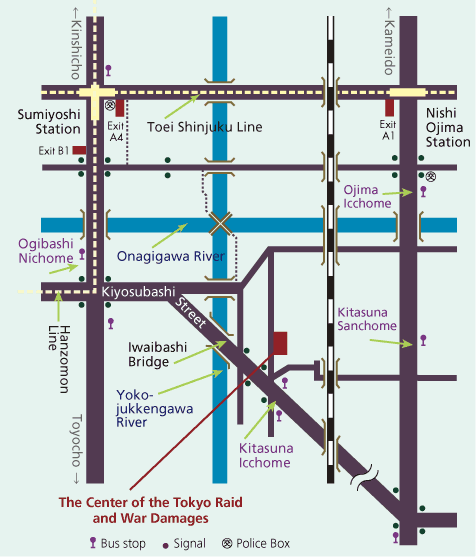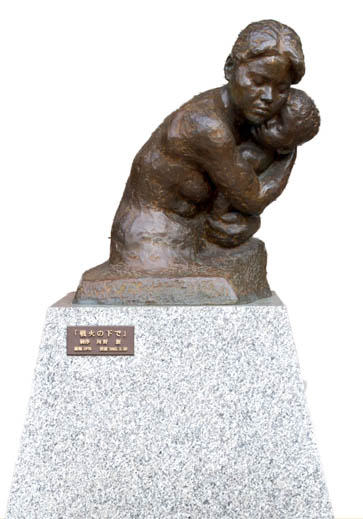An Overview of Air Raids in Tokyo
Aerial photo of Shin-Ohashi, Fukagawa and Joto City, September 1945 (photo by the U.S Military)
★=Location of this museum
The American military captured the Mariana Islands and converted them into a base of operations near the end of World War II. This made it possible for the B-29 aircraft to bomb most of the Japanese mainland and marked the beginning of full-scale air raids in Japan. Bombings of Tokyo began from November 24th, 1944.
At first, air raids were conducted during the day from high altitude and primarily targeted factories essential to Japan’s military operations. Within Tokyo Prefecture, the first bombing target was a factory that produced aircraft parts in the Tama region west of the official capital city area. However, the American military soon switched from only targeting military facilities to also indiscriminately bombing urban areas. These air raids made use of incendiary bombs to completely burn down heavily populated residential districts.
During the so-called “Great Tokyo Air Raid” on March 10th, 1945, the urban area centered around the Shitamachi part of the city was selected as the primary bombing target. The entirety of the area from the Sumida River to the Arakawa River (present day Sumida Ward and Koto Ward) and many neighborhoods on the west bank of the Sumida River such as Asakusa and Nihonbashi were completely reduced to ash. It is estimated that more than 100,000 people died that night. The causes of death included burning, suffocation, drowning, freezing, and more.
Throughout World War II, Chongqing, Dresden, and many other cities were bombed indiscriminately (note 1). Furthermore, Hiroshima and Nagasaki were also hit with nuclear bombs (note 2). Much like these other air raids, the Great Tokyo Air Raid was one of the bombings with the highest casualties in the war.
Between March and May, the wards of Tokyo were bombed repeatedly. By the end of May, most of the main urban area had been lost to fire. After the large cities were destroyed, medium and small-sized cities around the country were also targeted, including Hachioji in Tokyo Prefecture.
- Note 1: China’s wartime capital of Chongqing was bombed repeatedly by the Japanese military from 1938 to 1943. It is estimated that there were more than 10,000 deaths. Dresden was bombed by the Allies in February of 1945, resulting in as many as 25,000 deaths.
- Note 2: As of the beginning of November, 1945, deaths in Hiroshima were estimated at 130,000 people and 60,000 to 70,000 people in Nagasaki.
What is the Center of the Tokyo Raids and War Damage?
 The Center of the Tokyo Raids and War Damage was constructed thanks to the individual private donations of more than 4,000 people. The donors desired to pass on knowledge of the horrors of the Great Tokyo Air Raid to future generations. They hoped that the center would serve as a space to advance research and the study of peace. The first director of the center was Katsumoto Saotome, and many of the original staff were people who had directly experienced the bombings. Since opening on March 9th, 2002, the center has served as a privately-built, privately-run museum and archive for air raids and war damage (note 1).
The Center of the Tokyo Raids and War Damage was constructed thanks to the individual private donations of more than 4,000 people. The donors desired to pass on knowledge of the horrors of the Great Tokyo Air Raid to future generations. They hoped that the center would serve as a space to advance research and the study of peace. The first director of the center was Katsumoto Saotome, and many of the original staff were people who had directly experienced the bombings. Since opening on March 9th, 2002, the center has served as a privately-built, privately-run museum and archive for air raids and war damage (note 1).
Currently, the center has exhibits on the history of air raids, the daily lives of civilians during wartime, the weapons used in air raids, the experiences and suffering of regular citizens of Tokyo during the air raids, and more. The goal of the center is to teach about the suffering of everyday people during wartime, particularly during air raids. We hope that by spreading awareness, we can help prevent the tragedy of war from reoccurring and contribute to the creation of a more peaceful world.
- Note 1: The center also belongs to The Institute of Politics and Economy, a public interest incorporated foundation.
Floor Guide
leaflet ⇒ English leaflet
Information
| Hours | Tuesday~Sunday 10:30~16:00 |
| Closed | Monday Year-end & New Year Holidays(December 28 to January 4) *if Monday is a holiday, the museum opens on Monday and close on Tuesday *Open on March 9 and 10(regardless of the day of the week) |
Admissions(including tax)
| Adults | 300 yen |
| Jr. / Sr. high school students | 200 yen |
| Elementary school students | 100 yen |
| Preschoolers and disabled persons | Free |
Remarks
- For groups of more than 10 people, please contact us in advance.
- There is a wheelchair elevator, a toilet, and a parking lot. There is no public parking available.
- For groups, We’re available for consultation after hours and on closed days.
Access
◆From JR Akihabara Station: after passing through the central gate, go to the No.2 bus terminal on the left. Take the bus bound for “Kasai Eki” for 35 minutes. Get off at Kitasuna Icchome. Two minute walk.
◆From JR Kinshicho Station: from the No. 3 bus terminal outside the south gate, take the bus bound for “Toyocho / Tokyo Eki Marunouchi Kitaguchi” and get off at Ohgibashi Nichome. Ten minute walk.
◆From Tokyo Metro, Tozai Line, Toyocho Station: from the No. 5 bus terminal on the Yotsume Dori side, take the bus bound for “Kinshicho” and get off at Ohgibashi Nichome. Ten minute walk.
◆From JR Tobu Line, Kameido Station: from the No.2 bus terminal, take the bus bound for “Nagisa Nyu Taun / Nishi Kasai Ekimae” and get off at Ojima Icchome. Thirteen minute walk. Get off at Kitasuna Sanchome. Seven minute walk.
◆From Kiyosumi-Shirakawa Station on either the Tokyo Metro, Hanzomon Line or the Toei Subway, Oedo Line: from the No. 3 bus terminal, take the bus bound for “Kasai Eki” to Kitasuna Icchome. Two minute walk.
◆From Tokyo Metro, Tozai Line, Kasai Station: from the No. 3 bus terminal, take the bus bound for “Akihabara Eki” for twenty minutes. Get off at Kitasuna Icchome. Two minute walk.
◆Walk eighteen minutes from either Toei Subway, Shinjuku Line, Sumiyoshi Station (Exit A4) or Nishi Ojima Station (Exit A1).
◆Walk fifteen minutes from Tokyo Metro, Hanzomon Line, Sumiyoshi Station (Exit B1).
Located next to Iwaibashi Seikeigeka (Iwaibashi Orthopedic Clinic) on the Iwaibashi Higashizume Intersection of Kiyosubashi Street.


